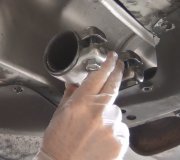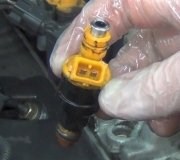Well the second winter I had it, I ran into a road sign with it. The road sign missed my bumper support and driver side tire but managed to sheer my wiring harness to my PCM along with damaging the PCM. I replaced the PCM with one from a 2002 or 2003 Pt Cruiser from a junk yard as it was all I could find (Did not get it programmed as it worked when I put it in). I replaced the plug along with 18'' of the wiring harness, making sure to shrink wrap all the wires individually along the way so I would not mis-match any. Car seemed to run fine, lucky me.
About a year after replacing the PCM (roughly 100,000 miles)it developed a rough idle and smokey/steamy exhaust at idle. Even after being driven, steam would come from the exhaust at idle along with a gas/antifreeze smell inside the car when stopped. (Was only getting 200 miles to 13 Gallons gas Avg.)
I replaced everything it seems (gas tank, fuel pump, cam position sensor, cold air intake sensor, throttle position sensor, egr valve) One thing I found was cylinder #4 was running leaner than the rest (Chalky white tip on spark plug). Well changed spark plugs and wires to no avail and dealt with it as my father said "it doesn't seem that bad, might be normal for rough idle at that mileage".
Well at 130,000 miles and another year passing, my oil drain plug loosened and leaked enough oil for it to be just noticable at the end of the dipstick. This caused a severe "chug chug chug" at idle (very noticable). I changed the oil and the severe "chug chug" at idle didn't change, it just worsened to where it lurked the car forward. Compression test revealed cylinder number 1 to be 35 psi below the other 3 along with an oil soaked spark plug. All this time, no check engine light or error codes mind you.
I tore apart the motor which revealed exhaust valves on cylinder number 4 to be chalky white just like the spark plug in that cylinder. The exhaust valves get darker as you go in reverse order (3, 2, 1) 3, 2, 1 are all healthy colors except one intake valve on cylinder 1 which was soaked in oil (expected as thats the cylinder that sprayed oil on the spark plug and had the 35psi drop).
Now I had the motor replaced with one that only has 47,000 miles. I still have the bad gas mileage, smokey/steamy exhaust and gas/antifreeze? Smell inside the cabin when stopped idling anywhere. Replaced upstream O2 sensor but no difference. No error codes or CEL still. No rough idle with this new motor but am afraid it will develop one. I have only put 6,000 miles on this new motor and do not wish to go through another one.
Also the old motor heated up quickly, less than 1 mile of driving (30mph) when it was 10 degrees outside and the temperature would start to rise towards normal operating temperature. That didn't start until the steamy exhaust/ rough idle started. Now my new motor also starts to rise toward the operating temperature with less than 1 mile of driving (30 mph). Antifreeze is always full in radiator but overflow tank goes empty after a month of being filled. Coolant fan has been replaced and works.
Do you think the PCM is the culprit or one of the Vacuum lines? Those are the only 2 constants I can think of, between the 2 motors. Sorry for the lengthy message but felt it necessary to show all possibilities.
Thanks a lot for your help and time,
Joseph
SPONSORED LINKS
Monday, January 3rd, 2011 AT 12:52 AM



